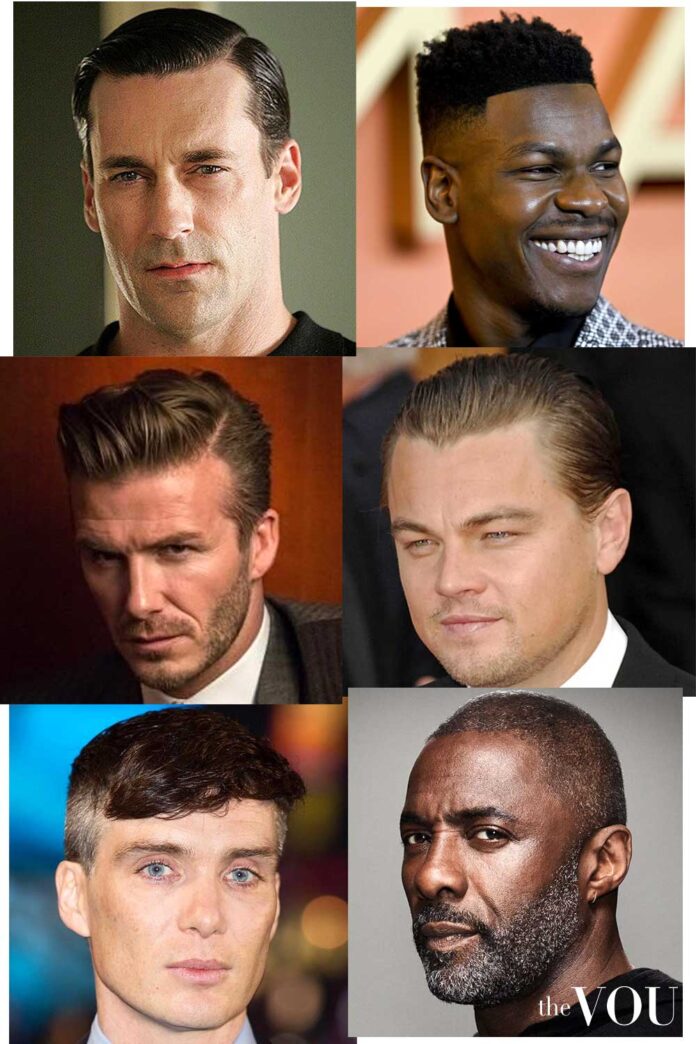In the ever-evolving landscape of men’s fashion, classic haircuts stand as pillars of timeless elegance, and these classic hairstyles remain timeless, transcending fleeting trends.
By offering a refined aesthetic that withstands the test of time, these classic haircuts are suitable for all occasions, while enhancing your natural features.
From boardrooms to social gatherings, these hairstyles convey a sense of self-assurance and attention to detail that resonates across generations.
In this comprehensive guide, we explore 11 classic men’s haircut styles that have withstood the test of time, examining face shape compatibility, hair type suitability, maintenance requirements, and styling techniques.
Whether you’re a seasoned style enthusiast or new to men’s grooming, this guide offers valuable insights into the art of classic men’s hairstyles.
1. The Ivy League – Academic Charm
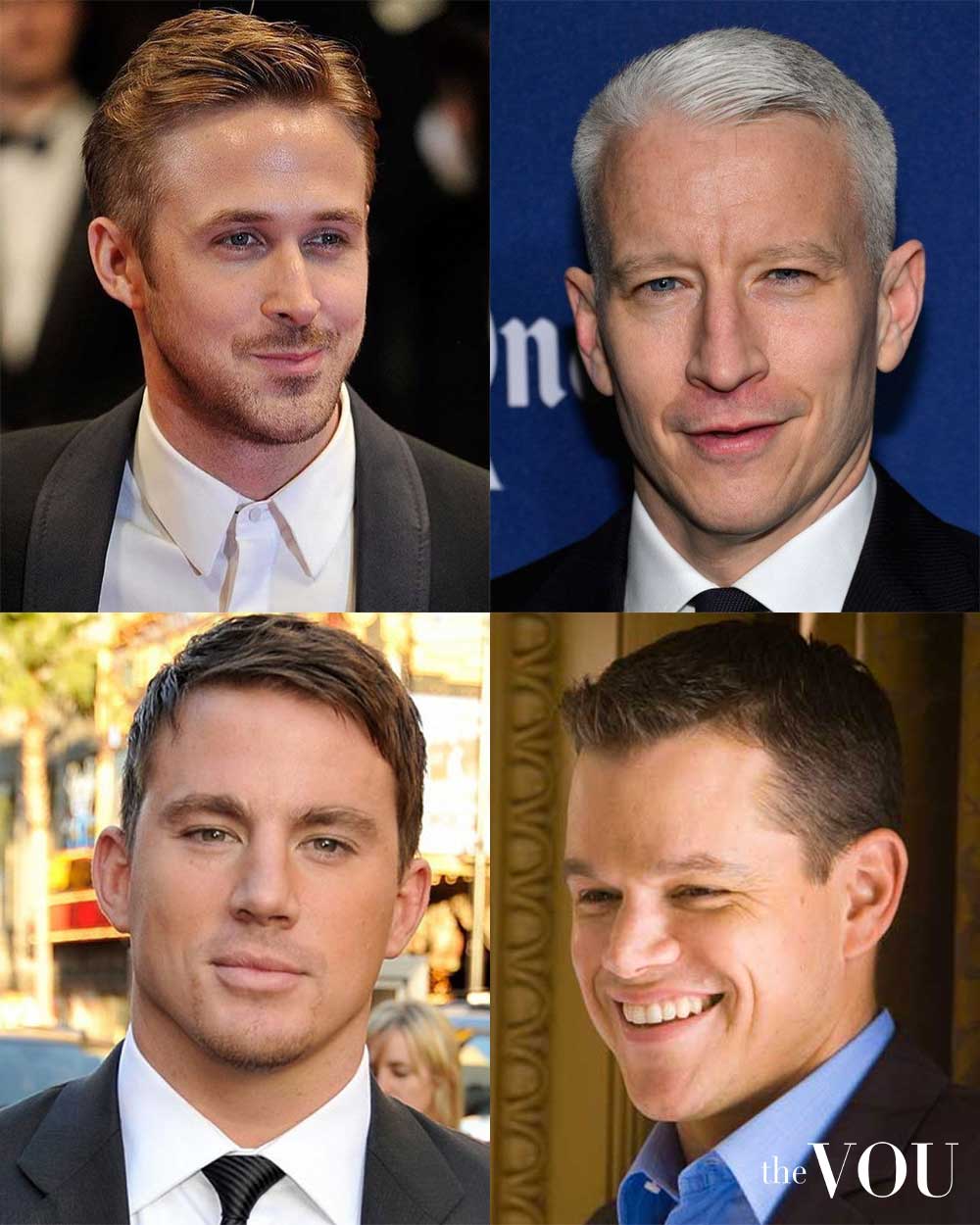
The Ivy League haircut epitomises academic charm, characterised by its short, neat appearance with a slightly longer top that can be parted or brushed.
This refined style bridges the gap between the crew cut and the side part, offering a polished look that exudes intelligence and sophistication.
Face Shape Suitability
Oval faces benefit from the Ivy League’s balanced proportions, enhancing natural features without overwhelming them.
For square faces, the short sides accentuate strong jawlines, while the slightly longer top softens the overall appearance.
Round faces can achieve a more elongated look by styling the top with added height and keeping the sides very short.
Those with heart-shaped faces should maintain some length on top to balance a wider forehead with a narrower chin.
Men with diamond-shaped faces can use the style’s versatility to add width at the forehead and chin areas.
Hair Type Considerations
Straight hair showcases the Ivy League’s clean lines and neat appearance most effectively.
Wavy hair can add an interesting texture to the longer top, creating a more dynamic version of the classic style.
Thick hair may require thinning on top to achieve the desired neat appearance and to prevent excessive bulk.
Fine hair benefits from the shorter length, which can create the illusion of fuller, denser hair.
Curly hair requires precise cutting techniques to manage volume and preserve the style’s characteristic neatness.
Maintenance Requirements
Regular trims every 2-3 weeks are essential to maintain the precise shape and length of the Ivy League cut.
Daily styling typically involves minimal effort, requiring only a small amount of product and basic grooming, such as combing or brushing.
Weekly deep cleansing helps prevent product buildup, particularly important due to the style’s short length.
Occasional use of a scalp scrub can help maintain scalp health and prevent dandruff, which can be more noticeable in shorter styles.
Styling Tips
Start with clean, towel-dried hair, applying a small amount of water-based pomade or styling cream to damp strands.
Use a fine-toothed comb to create a neat side part or brush the hair forward for a more textured look.
For a classic Ivy League appearance, comb the top section to one side, allowing it to lay flat against the head.
To add volume, use a blow dryer on low heat, directing the airflow upwards at the roots while combing.
Apply a small amount of matte finish product to hold the style in place without adding excessive shine.
For a more formal look, use a high-shine pomade and comb the hair neatly into place.
Historical Context
The Ivy League cut originated in the 1930s at prestigious Northeastern American universities, embodying a clean-cut, scholarly image.
It gained widespread popularity in the 1950s and 1960s, becoming synonymous with preppy style and upper-class sophistication.
The style has undergone various revivals, consistently representing a timeless and refined approach to men’s grooming.
Modern Variations
The Textured Ivy League incorporates more movement on top, using styling products to create a slightly dishevelled look.
The High and Tight Ivy League features an even shorter cut on the sides, creating a more dramatic contrast with the top.
The Ivy League Fade combines the classic top with a modern fade on the sides, offering a contemporary twist.
Professional vs Casual Adaptability
In professional settings, maintain a crisp part and smooth styling for a polished, boardroom-ready appearance.
For casual occasions, introduce a slight texture to the top by gently smoothing it with your fingers and a matte product for a more relaxed interpretation.
The Ivy League’s versatility allows for easy transition between formal and informal looks through subtle styling adjustments.
Grooming Tools
Invest in a high-quality pair of hair scissors for touch-ups between barber visits, particularly for managing the longer top section.
A selection of combs, including both wide-tooth and fine-tooth varieties, enables precise styling.
Consider purchasing a small, travel-sized styling product for midday touch-ups, maintaining the style’s neat appearance throughout the day.
Common Mistakes
Avoid cutting the top too short, which can result in a crew cut rather than the characteristic Ivy League style.
Refrain from using excessive product, which can make the short hair appear greasy or weighed down.
When styling, ensure the part is straight and well-defined to maintain the cut’s classic, precise appearance.
Celebrity Examples
Actor Matt Damon frequently sports variations of the Ivy League cut, showcasing its suitability for film roles and formal events.
Former President John F Kennedy maintained an Ivy League cut throughout his presidency, illustrating the style’s association with leadership and professionalism.
These examples highlight the Ivy League cut’s enduring appeal across various professions and its ability to convey a sense of trust, intelligence, and refined taste.
2. The Classic Taper – Subtle Refinement
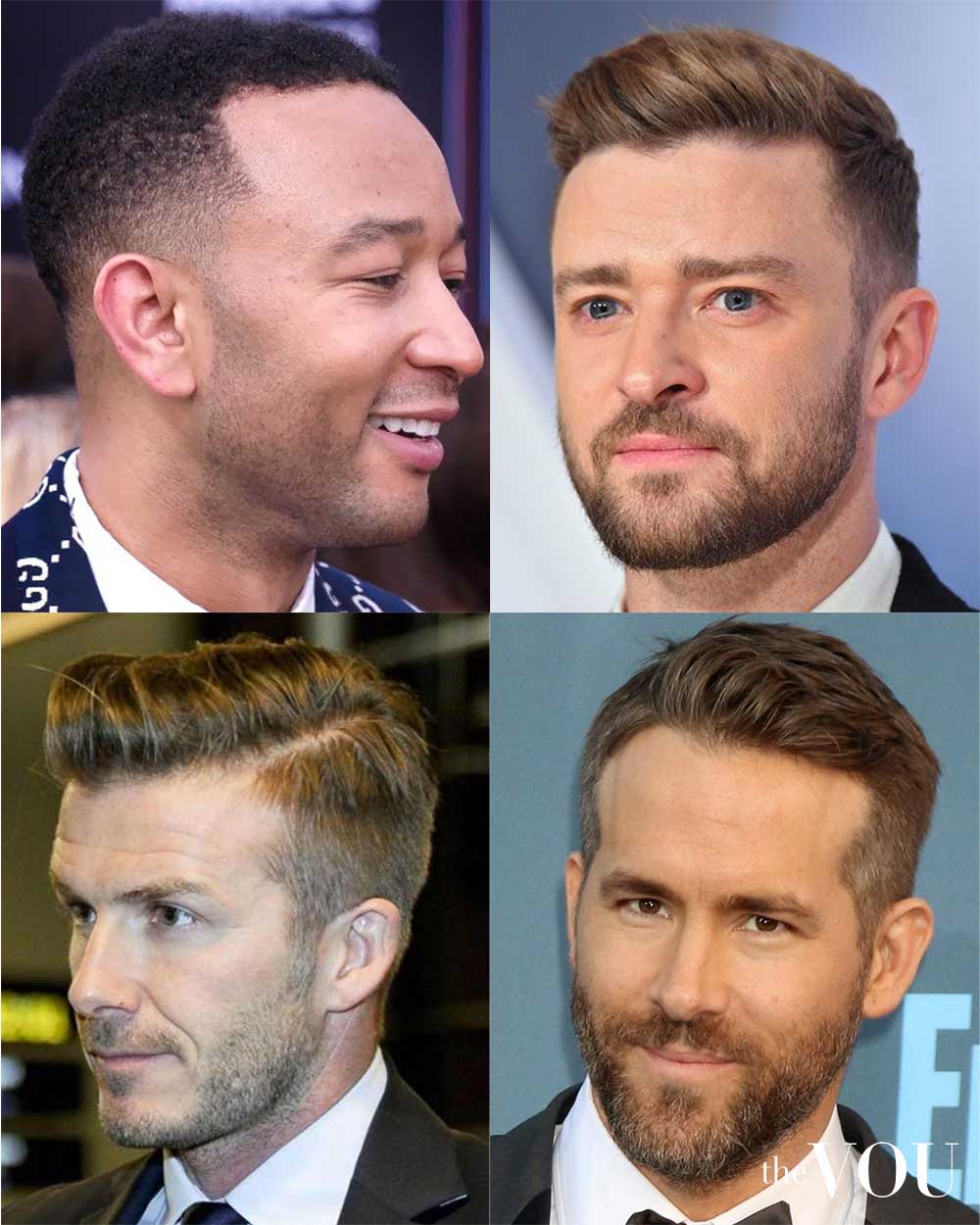
The Classic Taper embodies subtle sophistication, characterised by its gradual reduction in hair length from the top of the head down to the nape and sides.
This timeless style offers a clean, polished appearance that seamlessly blends traditional barbering techniques with modern grooming sensibilities.
Face Shape Suitability
Oval faces benefit from the Classic Taper’s balanced proportions, enhancing natural features without overpowering them.
For square faces, a slightly longer top with a gradual taper softens strong jawlines while maintaining a masculine edge.
Round faces can achieve a more angular appearance with higher contrast between the longer top and closely tapered sides.
Those with diamond-shaped faces should maintain some volume on the sides to balance wider cheekbones.
Men with longer faces can opt for a lower-contrast taper to avoid exaggerating facial length.
Hair Type Considerations
Straight hair showcases the precision of the Classic Taper most effectively, highlighting the smooth graduation of length.
Wavy hair adds natural texture to the style, creating an interesting interplay between the longer top and tapered sides.
Thick hair benefits from internal layering techniques to remove bulk and enhance the taper’s clean lines.
Fine hair can appear to gain density through strategic cutting and styling techniques.
Curly hair requires careful tapering to manage volume and maintain a neat silhouette.
Maintenance Requirements
Regular trims, every 3-4 weeks, are crucial to maintaining the taper’s precise graduation and overall shape.
Daily styling typically involves minimal effort, often requiring only a small amount of product and basic combing.
Weekly deep cleansing helps prevent product buildup, particularly in shorter areas where accumulation is more noticeable.
Occasional use of a clarifying shampoo helps maintain the health and responsiveness of both the hair and scalp.
Styling Tips
Begin with clean, towel-dried hair, applying a small amount of lightweight styling cream or lotion to damp strands.
Use a comb to create a neat side part or sweep the hair back, depending on personal preference and hair length.
For added control, use a blow dryer on a low heat setting and guide the hair into place with fingers or a brush.
Once dry, apply a dime-sized amount of pomade or styling wax, working it through the hair from roots to tips.
Use a fine-toothed comb to refine the part and smooth any flyaways, particularly along the tapered sides.
Finish with a light mist of flexible hold hairspray to maintain the style throughout the day without stiffness.
Historical Context
The Classic Taper has roots in military grooming standards, prized for its neat, low-maintenance appearance.
It gained civilian popularity in the 1950s and 1960s as a symbol of clean-cut masculinity and professionalism.
The style has endured through various fashion cycles, consistently representing timeless elegance in men’s grooming.
Modern Variations
The Textured Taper incorporates more layering on top for a contemporary, slightly dishevelled appearance.
The High Contrast Taper features a more dramatic difference between the longer top and closely cropped sides.
The Taper Fade combines the classic taper with a modern fade technique, offering a sleek, updated look.
Professional vs Casual Adaptability
In professional settings, maintain a crisp part and smooth styling for a polished, boardroom-ready appearance.
For casual occasions, introduce a slight texture to the top using fingers and a matte product for a relaxed yet neat look.
The Classic Taper’s versatility allows for easy adaptation to various dress codes through subtle styling adjustments.
Grooming Tools
Invest in a high-quality set of hair clippers with multiple guard lengths for at-home maintenance between barber visits.
A selection of combs, including both wide-tooth and fine-tooth varieties, enables versatile styling options.
Consider purchasing a small, handheld mirror to check the precision of the taper at the back of the head.
Common Mistakes
Avoid creating too sharp a contrast between the top and sides, which can result in an unbalanced appearance.
Refrain from over-applying products, which can weigh down the hair and diminish the taper’s clean lines.
When maintaining at home, be cautious not to cut the taper too high, as this can be difficult to correct without professional intervention.
Celebrity Examples
Actor Ryan Reynolds frequently sports a well-executed Classic Taper, demonstrating its suitability for both red-carpet events and casual appearances.
Football player David Beckham has showcased various iterations of the Classic Taper throughout his career, highlighting its enduring appeal in sports and celebrity culture.
Singer John Legend often opts for a precisely tapered style, illustrating how the cut complements a range of formal and informal ensembles.
3. The Textured Cut with Fringe – Casual Style
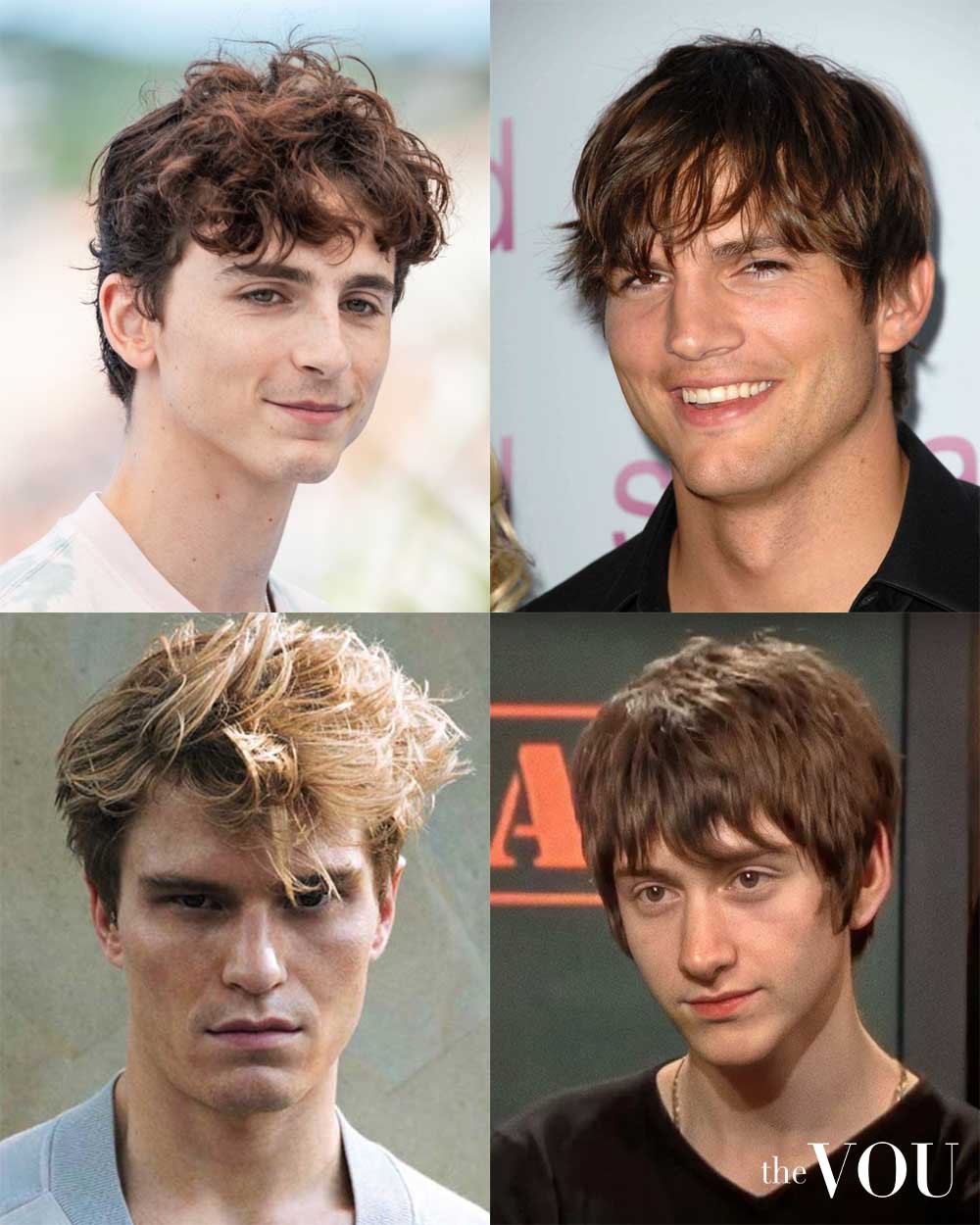
The Textured Cut with Fringe epitomises effortless style, characterised by its deliberately tousled appearance and face-framing front section.
This contemporary style blends casual charm with structured sophistication, offering a versatile look that suits both professional environments and relaxed settings.
Face Shape Suitability
Oval faces benefit from the balanced proportions of this cut, with the fringe enhancing natural features without overwhelming them.
For square faces, a softer, choppier fringe helps to soften strong jawlines, creating a more harmonious overall appearance.
Round faces can utilise a slightly longer, side-swept fringe to create the illusion of length and angles, balancing facial curves.
Those with heart-shaped faces should opt for a textured fringe fuller at the sides, balancing a wider forehead with a narrower chin.
Men with longer faces can opt for a straighter, heavier fringe to visually shorten their face and create width.
Hair Type Considerations
Straight hair provides an excellent canvas for this style, allowing for precise texturising and a clean line in the fringe.
Wavy hair naturally enhances the textured aspect, requiring less styling product to achieve the desired tousled effect.
Those with thick hair benefit from internal layering techniques to remove bulk and enhance movement in the style.
Fine hair can gain the appearance of volume through strategic cutting and the use of texturising products.
Curly hair may require additional fringe management techniques, such as careful thinning or straightening methods.
Maintenance Requirements
Regular trims every 4-6 weeks are essential to maintain the shape and prevent the fringe from becoming unmanageable.
Daily styling involves using texturising products and potentially heat tools to achieve the desired tousled effect.
Weekly deep conditioning treatments help maintain hair health, mainly when heat styling is frequently used.
Occasional use of a clarifying shampoo helps prevent product buildup, ensuring the hair remains responsive to styling.
Styling Tips
Begin with freshly washed, towel-dried hair, applying a small amount of sea salt spray or texturising cream from roots to ends.
Use a blow dryer with a diffuser attachment on a low heat setting, scrunching the hair to enhance natural texture.
Once dry, work a pea-sized amount of matte styling paste or clay through the hair, focusing on creating a piece-y, defined look.
Style the fringe by gently pulling sections forward and manipulating them with fingers for a naturally messy look.
For added hold and separation, lightly mist the styled hair with a dry texturising spray, focusing on the roots for volume.
Historical Context
The Textured Cut with Fringe emerged in the late 1990s and early 2000s, influenced by the grunge and indie music scenes.
It gained mainstream popularity in the mid-2000s as a more stylised alternative to the clean-cut looks of previous decades.
The style has evolved to incorporate elements of classic barbering, resulting in a more refined, versatile look.
Modern Variations
The Messy Crop variation features a shorter overall length, with a highly textured top and fringe, making it suitable for a more edgy appearance.
The Textured Pompadour Fringe combines volume at the crown with a styled fringe, offering a modern take on classic 1950s styling.
The Disconnected Textured Cut incorporates stark length differences between the top and sides, creating a bold, contemporary silhouette.
Professional vs Casual Adaptability
For professional settings, the fringe can be styled more neatly, with reduced texture and a side-swept direction.
In casual contexts, opt for fuller texture and a more random fringe placement for an effortless, relaxed appearance.
The style’s versatility allows for an easy transition between formal and informal looks through subtle styling adjustments.
Grooming Tools
Invest in high-quality texturising shears for at-home touch-ups and fringe maintenance.
A vented brush with mixed bristles helps create texture during the blow-drying process.
Consider purchasing a small, travel-sized dry shampoo for mid-day refreshes and added texture.
Common Mistakes
Avoid over-styling the fringe, which can result in a rigid, unnatural appearance, contradicting the style’s effortless essence.
Refrain from using heavy, greasy products that can weigh down the hair and diminish the desired textured effect.
When cutting at home, resist the temptation to create a perfectly even fringe, as slight irregularities contribute to the style’s character.
Celebrity Examples
Actor Timothée Chalamet frequently sports variations of this style, showcasing its youthful and versatile appeal.
Musician Alex Turner of Arctic Monkeys has made the textured cut with fringe a signature part of his evolving image.
Model Oliver Cheshire demonstrates how this style can be adapted for high-fashion contexts, proving its versatility.
4. The Hi-Top Fade – Contemporary Edge
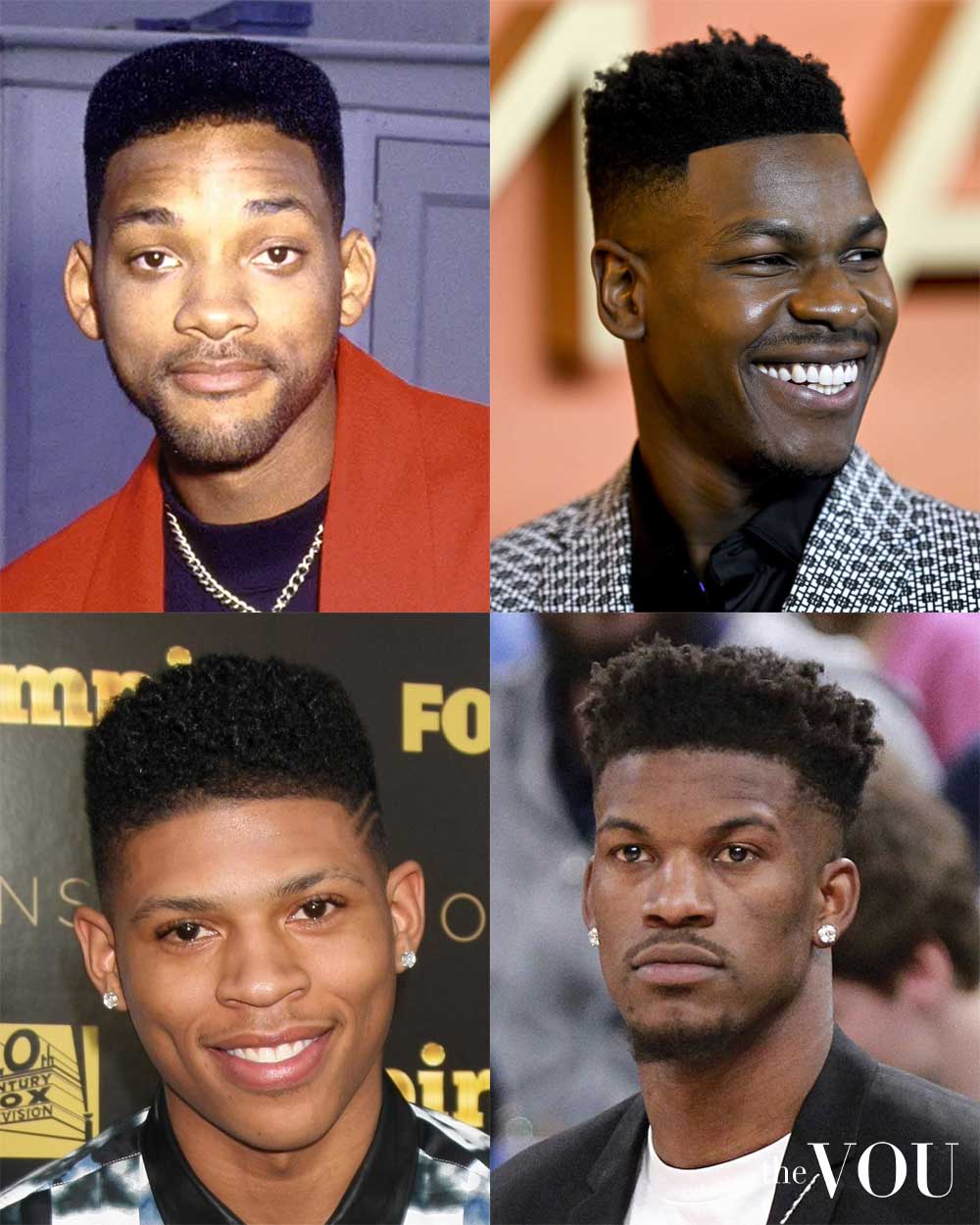
The Modern Hi-Top Fade represents a contemporary edge, characterised by its bold, vertical silhouette and crisp lines.
This style combines classic barbering techniques with modern aesthetics, making it a standout choice for men seeking a powerful, fashion-forward look.
Face Shape Suitability
The Modern Hi-Top Fade complements oval and diamond-shaped faces, adding height and structure.
For round faces, a higher top with square edges creates a slimming effect.
Square faces benefit from slightly softer edges to balance strong jawlines.
Those with longer faces should opt for a lower height to maintain proportional balance.
Hair Type Considerations
This style is ideally suited for those with afro-textured hair, showcasing its natural volume and strength.
Coarse, thick hair provides the best foundation for achieving and maintaining the style’s distinctive shape.
Those with looser curls may require additional product and styling to achieve the desired height and structure.
Individuals with straight or fine hair types typically cannot achieve this look without significant alteration.
Maintenance Requirements
The modern hi-top fade requires regular maintenance to preserve its sharp lines and shape.
Visiting a skilled barber every 2-3 weeks is essential to maintain the fade and overall structure.
Daily styling is crucial to keep the top neat and defined, and regular moisturising is vital to prevent dryness and maintain hair health.
Styling Tips
Begin with freshly washed and conditioned hair.
Use a pick or wide-toothed comb to detangle and shape the top section.
Apply a strong-hold mousse or styling cream to damp hair, working it through from roots to tips.
Use a blow dryer with a diffuser attachment to enhance volume, directing air upwards.
Shape the top with hands or a sponge brush to create the desired silhouette.
Finish with a light mist of strong-hold hairspray to set the style.
Historical Context
The Hi-Top Fade originated in the 1980s as part of hip-hop culture, symbolising urban style and individuality.
It gained mainstream popularity in the late 1980s and early 1990s through music and sports icons.
The modern iteration emerged in the 2010s, blending classic elements with contemporary barbering techniques.
Modern Variations
The Tapered Hi-Top Fade features a more gradual transition from the sides to the top.
The Textured Hi-Top features looser, more natural curls on top, creating a softer appearance.
The Asymmetrical Hi-Top Fade plays with uneven lengths for a bold, avant-garde look.
Professional vs Casual Adaptability
In conservative professional environments, a more subdued version of the style may be more suitable.
For creative or casual settings, bolder heights and dramatic fades can be showcased.
The style’s versatility allows for adjustments in height and texture to suit various occasions.
Grooming Tools
A high-quality sponge or twist brush is essential for shaping and defining curls.
Invest in a powerful blow dryer with a diffuser attachment for volume enhancement.
A sharp line-up trimmer is crucial for maintaining crisp edges between appointments.
Common Mistakes
Avoid over-processing or heat damage, which can compromise the hair’s natural texture and volume.
Refrain from cutting the fade too high, creating an unbalanced appearance.
When styling, ensure even product distribution to prevent patchy or inconsistent texture.
Celebrity Examples
Actor Will Smith popularised the classic Hi-Top Fade in the 1990s, influencing a generation.
Actor John Boyega showcases a modern interpretation of the style, demonstrating its contemporary appeal.
Basketball player Jimmy Butler has sported variations of the Hi-Top Fade, illustrating its popularity in sports culture.
5. The Slick Back – Refined Charm
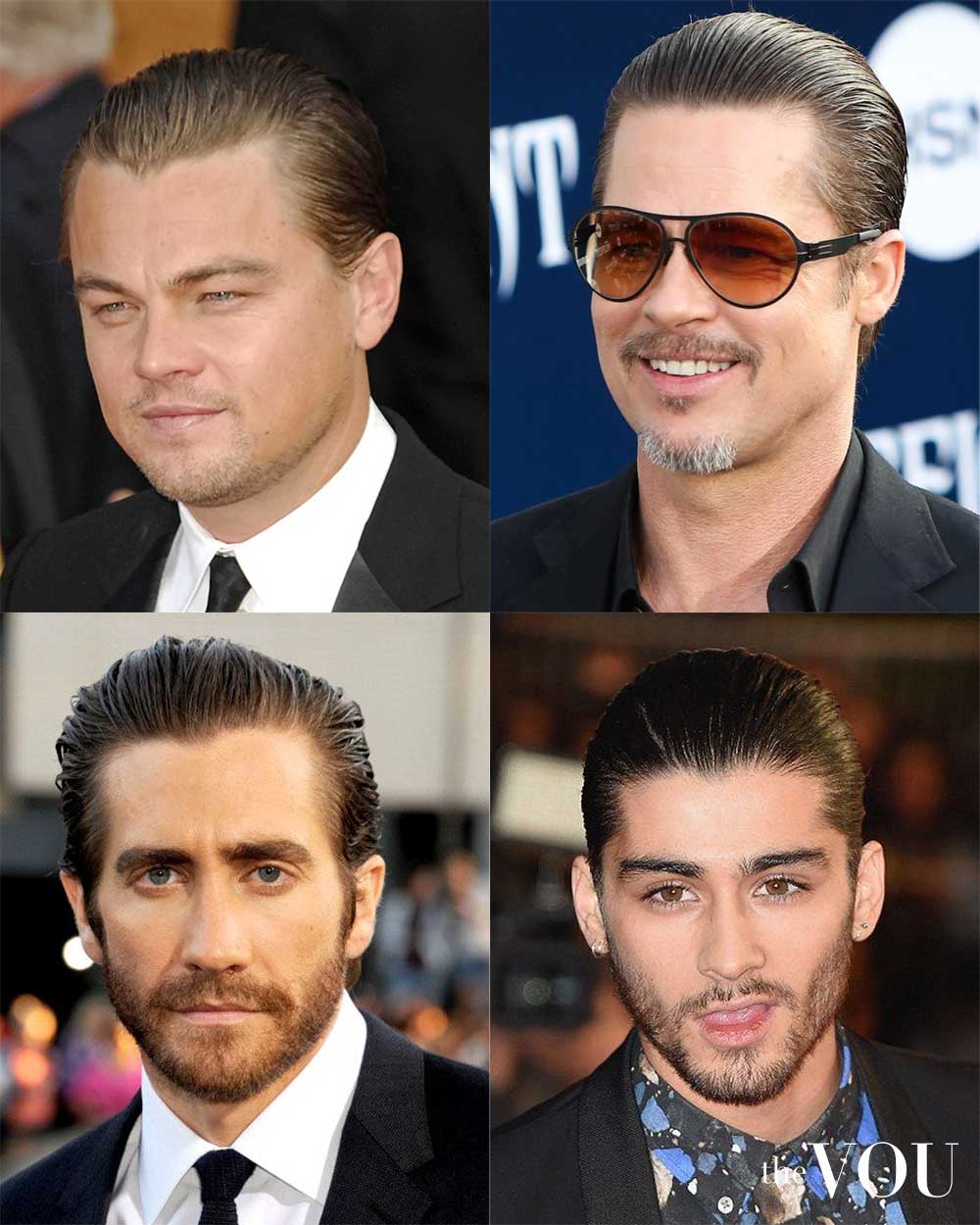
The Slick Back embodies refined charm, characterised by its smooth, swept-back appearance.
This sophisticated style exudes confidence and polish, making it a favoured choice for men seeking a look seamlessly transitioning from boardroom to social engagements.
Face Shape Suitability
The Slick Back complements a range of face shapes – oval faces benefit from their balanced proportions, while square faces find their strong jawlines accentuated.
For round faces, the style’s vertical lines create a lengthening effect.
Those with heart-shaped faces should maintain volume at the crown to balance wider foreheads.
Men with receding hairlines may find this style challenging, as it exposes the hairline.
Hair Type Considerations
Straight to slightly wavy hair textures achieve the Slick Back most effortlessly.
Fine hair requires volumising products to prevent a flat appearance, while thick hair benefits from thinning techniques to ensure a smooth finish.
Extremely curly hair may struggle to maintain the style’s sleek lines without significant effort and product use.
Maintenance Requirements
The Slick Back demands regular maintenance to preserve its polished aesthetic.
Trimming every 4-6 weeks maintains the style’s shape and prevents excessive length at the nape.
Daily styling is necessary, involving thorough combing and product application.
Weekly deep conditioning treatments help counteract potential damage from frequent styling and product use.
Styling Tips
To achieve the quintessential Slick Back, begin with damp hair.
Apply a small amount of heat protectant before blow-drying the hair backwards using a round brush for volume and direction.
Once dry, work a marble-sized amount of high-shine pomade through the hair, starting from the roots and combing backwards.
For a more textured finish, substitute pomade with matte clay. Secure the style with a light misting of strong-hold hairspray.
Historical Context
The Slick Back gained prominence in the 1920s, embodying the sleek sophistication of the era’s gentlemen.
It experienced a resurgence in the 1980s Wall Street culture, symbolising power and success.
Today, it represents a timeless elegance that transcends fleeting trends.
Modern Variations
Contemporary interpretations include the Textured Slick Back, incorporating volume and movement for a less rigid appearance.
The Slick Back Fade combines the classic swept-back top with faded sides, offering a modern edge.
For a more relaxed take, the Loose Slick Back allows for softer lines and natural movement.
Professional vs Casual Adaptability
In professional settings, maintain a sleek, high-shine finish using oil-based pomades for a classic executive look.
For casual occasions, opt for a softer hold product and allow some natural texture to emerge, creating a more relaxed aesthetic.
The style’s versatility allows for easy transition between formal and informal environments by adjusting product choice and application technique.
Grooming Tools
Essential tools for the Slick Back include a high-quality wide-toothed comb for initial styling and a fine-toothed comb for precision finishing.
A powerful hair dryer with a concentrator nozzle ensures efficient styling.
Invest in a round brush with natural bristles to create volume and shape during blow-drying.
Common Mistakes
Avoid excessive products, resulting in a greasy appearance and potential scalp issues.
Neglecting to adapt the style to one’s hair type may lead to an unflattering finish, particularly for those with fine or thinning hair.
When styling, ensure thorough product distribution to prevent visible comb lines or uneven texture.
Celebrity Examples
Notable proponents of the Slick Back include actors Leonardo DiCaprio, Brad Pitt, and Jake Gyllenhaal, who frequently showcases the style on red carpets, demonstrating its enduring elegance.
David Beckham has sported variations of the Slick Back, illustrating its adaptability to athletic and formal contexts.
English singer Zayn Malik has also sported the Slick Back style with long hair, illustrating its popularity among younger demographics.
6. The Side Parting – Timeless Professionalism
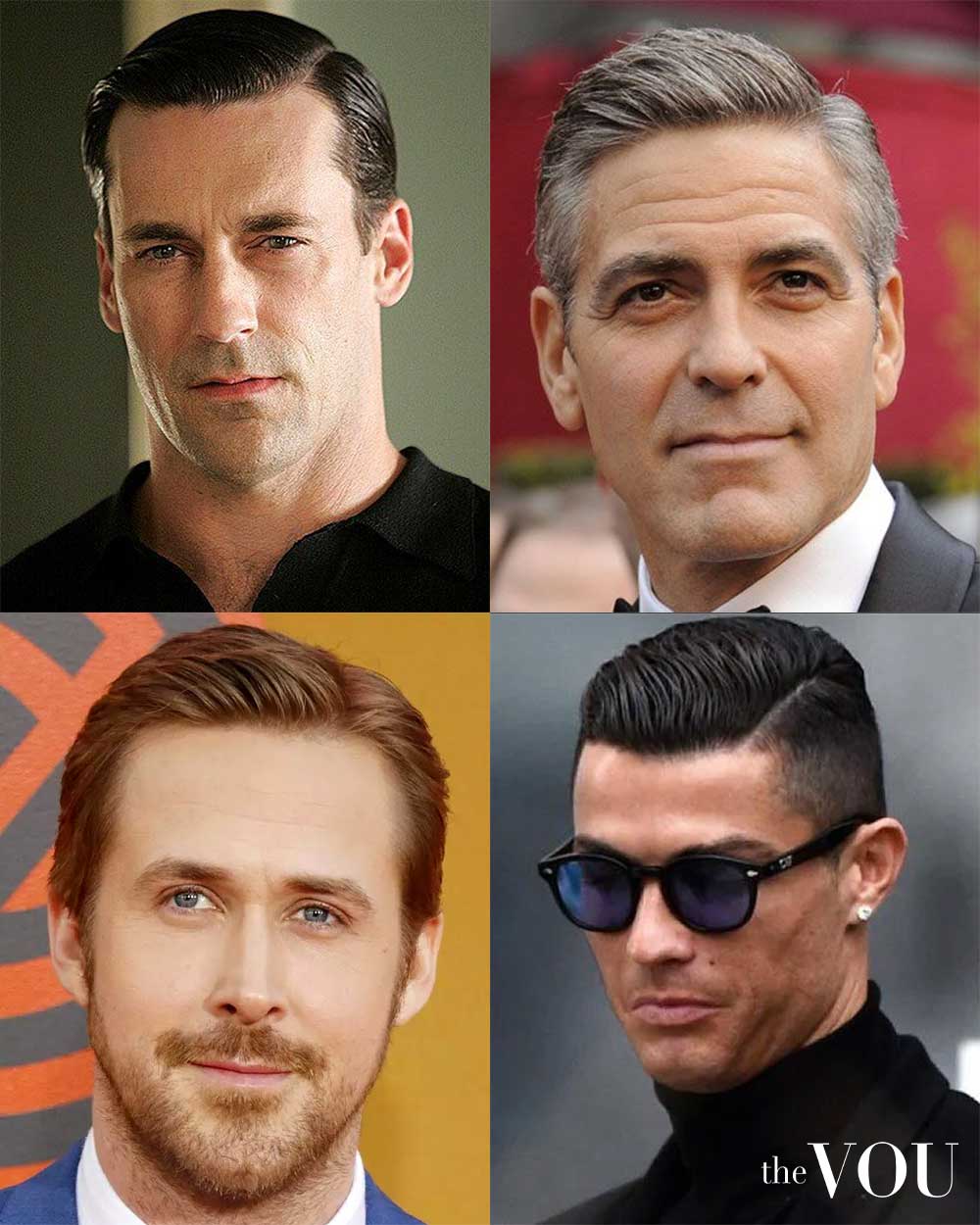
The Side Parting exemplifies timeless professionalism, characterised by its clean, defined line separating the hair into two distinct sections.
This classic style projects an air of refinement and attention to detail, making it a perennial favourite among gentlemen seeking a polished, versatile look.
Face Shape Suitability
The Side Parting adapts well to various face shapes. Oval faces benefit from their balanced proportions, while rectangular faces find their features softened by the style’s gentle curves.
For round faces, a deeper side part creates a slimming effect.
Those with diamond-shaped faces should opt for a softer part to balance angular features. Men with square faces can accentuate their strong jawlines with a crisp, defined parting.
Hair Type Considerations
Straight and wavy hair textures lend themselves naturally to the Side Parting.
Fine hair gains structure and volume from this style, particularly when combined with appropriate styling products.
Thick hair requires thinning to achieve a neat finish. Curly hair may need additional styling and product to maintain the part’s definition throughout the day.
Maintenance Requirements
The Side Parting requires regular upkeep to maintain its sharp appearance. Trimming every 3-4 weeks preserves the style’s shape and prevents overgrowth.
Daily styling is essential, involving careful combing and product application. Weekly deep cleansing removes product build-up, ensuring the hair remains healthy and responsive to styling.
Styling Tips
To achieve the quintessential Side Parting, begin with freshly washed, damp hair. Apply a small amount of styling mousse for hold and volume.
Create the part using the tail of a fine-toothed comb, following the natural direction of hair growth.
Blow-dry the hair using a vented brush, directing each section away from the parting.
Once dry, apply a pea-sized amount of pomade or styling cream, working it through the hair from roots to tips.
Finish by combing the hair into place and setting it with a light mist of medium-hold hairspray.
Historical Context
The Side Parting rose to prominence in the 1920s, epitomising the dapper gentleman of the era.
It maintained its popularity through subsequent decades, symbolising reliability and professionalism.
The style experienced a resurgence in the 2010s as part of a broader revival of classic men’s grooming aesthetics.
Modern Variations
Contemporary interpretations include the Textured Side Part, incorporating tousled volume for a more casual appearance.
The Side Part Fade combines the classic top with faded sides, offering a modern twist.
For a bolder statement, the Deep Side Part shifts the parting line further to one side, creating a dramatic asymmetry.
Professional vs Casual Adaptability
In professional environments, maintain a crisp, well-defined part using high-shine products for a polished look.
For casual settings, relax the style by using matte products and allowing some natural texture to emerge.
The Side Parting’s versatility enables seamless transitions between formal and informal contexts through subtle product choice and styling technique adjustments.
Grooming Tools
Essential tools for the side parting include a high-quality fine-toothed comb for creating and maintaining the part and a wide-toothed comb for general styling.
A powerful hair dryer with a concentrator nozzle ensures precise styling. Invest in a vented brush with mixed bristles to create volume and shape during blow-drying.
Common Mistakes
Avoid creating a part that contradicts the natural growth pattern of your hair, as this can lead to styling difficulties and an unnatural appearance.
Refrain from using excessive product, which can weigh down the hair and diminish the style’s crisp lines.
When styling, ensure even product distribution to prevent visible inconsistencies in texture or shine.
Celebrity Examples
Prominent figures sporting the Side Parting include actor Ryan Gosling, who showcases a classic style interpretation, emphasising its timeless appeal.
George Clooney frequently adopts variations of the Side Parting, demonstrating its suitability for mature gentlemen.
Football player Cristiano Ronaldo has been seen with a modern take on the Side Parting, illustrating its adaptability to contemporary fashion.
Actor Jon Hamm popularised the style by portraying Don Draper in “Mad Men”, reinvigorating interest in this classic look.
7. The Pompadour – Iconic Volume
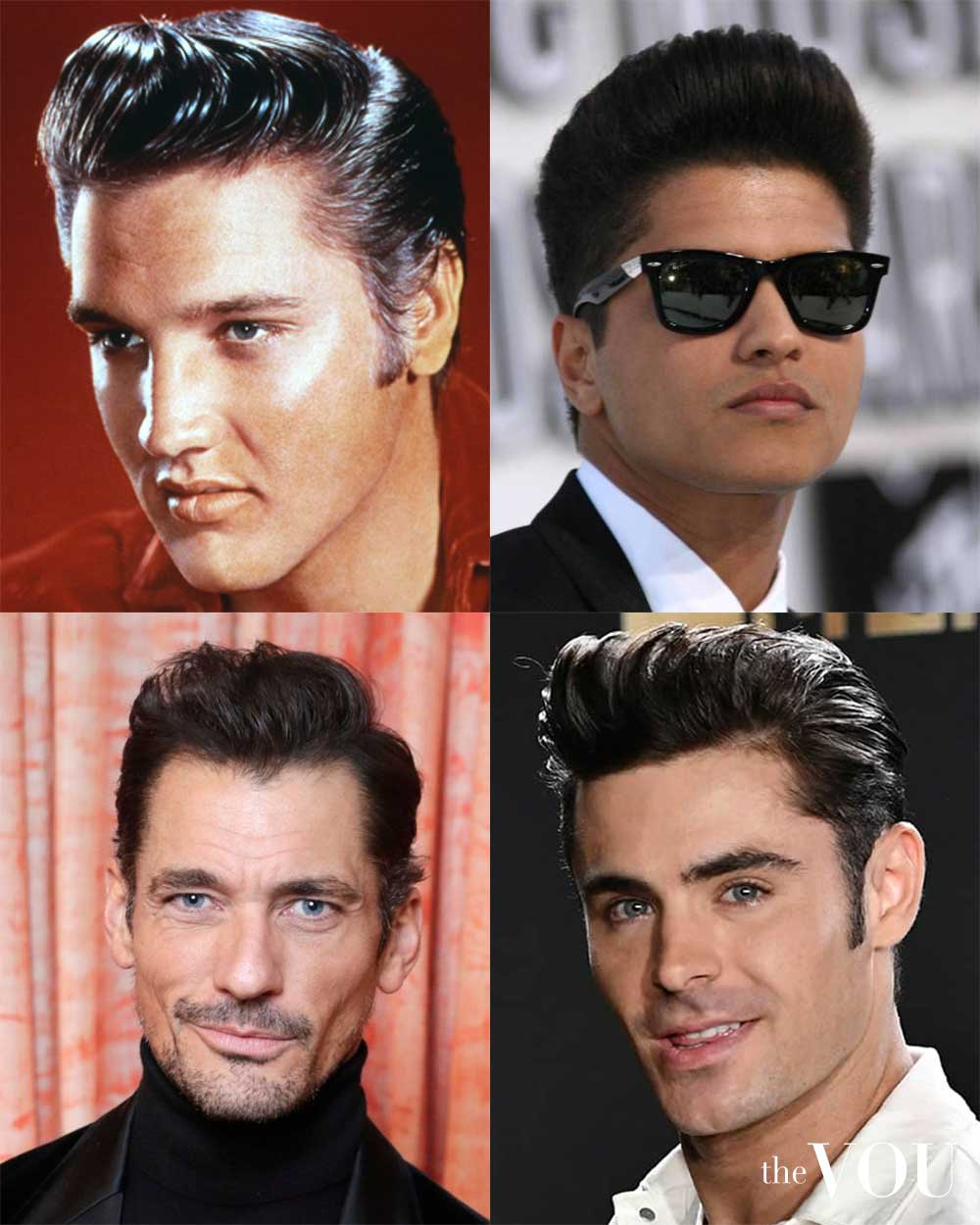
The Pompadour epitomises iconic volume, characterised by its swept-up frontal section and sleek sides.
This classic style exudes confidence and sophistication, offering a bold silhouette for men who appreciate timeless elegance with a touch of drama.
Face Shape Suitability
The Pompadour particularly flatters oval and rectangular face shapes, enhancing their natural balance.
For round faces, a higher pompadour with shorter sides creates a lengthening effect.
Square faces benefit from a softer, more textured top to balance strong jawlines.
Those with heart-shaped faces should opt for a moderate height to avoid overpowering the lower half of the face.
Hair Type Considerations
Straight to slightly wavy hair types achieve the classic Pompadour look most easily.
Thick hair provides excellent structure and hold for the style’s signature volume.
Fine hair may require additional product and teasing techniques to maintain height.
Curly hair can adapt to a textured Pompadour variant, embracing natural volume.
Maintenance Requirements
The Pompadour demands regular upkeep to maintain its polished appearance.
Trimming every 3-4 weeks ensures the sides remain neat and the top’s length is manageable.
Daily styling is essential, involving thorough blow-drying and product application.
Weekly deep conditioning treatments help counteract potential damage from frequent styling.
Styling Tips
Begin with damp, towel-dried hair and apply a volumising mousse to the roots.
Use a round brush while blow-drying, lifting the hair at the roots for maximum volume.
Once dry, work a dime-sized amount of pomade through the hair, focusing on the top section.
Shape the pompadour using a comb, sweeping the hair backwards and upwards.
Smooth the sides using a fine-toothed comb for contrast.
Set the style with a medium-hold hairspray, applied from a distance to maintain movement.
Historical Context
The Pompadour originated in the 18th century, named after Madame de Pompadour, chief mistress of Louis XV.
It gained popularity among men in the 1950s, becoming synonymous with rock and roll culture.
The style has experienced several revivals, adapting to contemporary grooming trends.
Modern Variations
The Textured Pompadour incorporates a more tousled top for a relaxed, contemporary look.
The Pompadour Fade combines the classic top with faded sides for a modern edge.
The Short Pompadour offers a subtler interpretation, suitable for professional environments.
Professional vs Casual Adaptability
For formal settings, maintain a sleek, well-defined shape using high-shine products.
In casual contexts, embrace a looser, more textured look with matte styling products.
The Pompadour’s versatility allows for adjustment in height and neatness to suit various occasions.
Grooming Tools
A high-quality round brush is essential for creating volume during blow-drying.
Invest in a powerful hair dryer with a concentrator nozzle for precise styling.
A tailcomb is crucial for shaping and defining the pompadour’s signature sweep.
Common Mistakes
Avoid using excessive products, which can weigh down the hair and diminish volume.
Refrain from creating a pompadour that’s disproportionately high for your face shape.
When styling, ensure the back and sides are sufficiently neat to contrast with the voluminous top.
Celebrity Examples
Elvis Presley iconically popularised the Pompadour, cementing its place in cultural history.
Actor Zac Efron has sported modern variations of the Pompadour, demonstrating its contemporary appeal.
Model David Gandy showcases a refined Pompadour, illustrating its suitability for high fashion contexts.
8. The Quiff – Versatile Allure
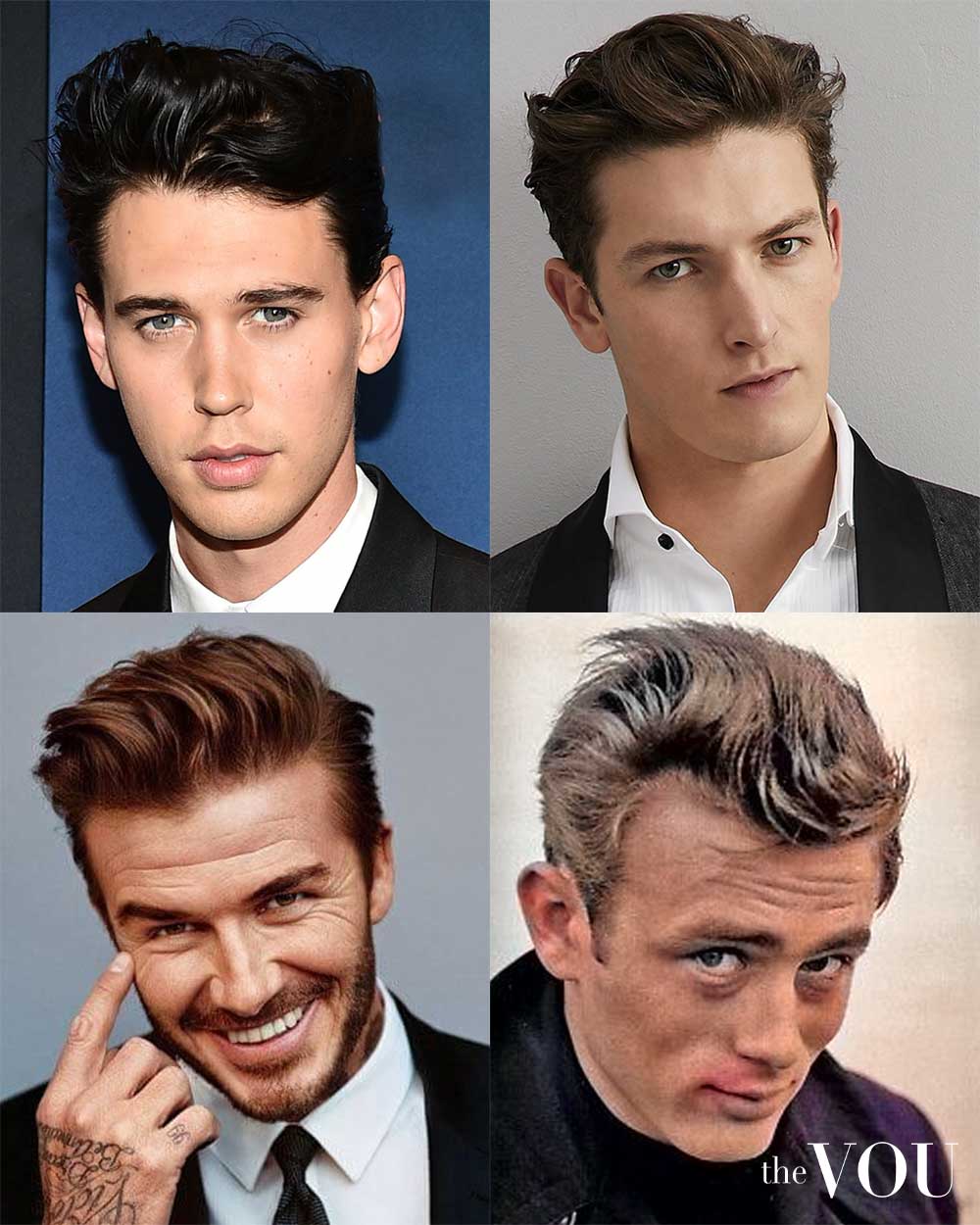
The Quiff embodies versatile allure, distinguished by its voluminous front styled upwards and backwards, gradually tapering towards the crown.
This dynamic style balances classic sophistication and contemporary flair, offering an adaptable look suitable for various occasions and personal styles.
Face Shape Suitability
The Quiff’s adaptability makes it suitable for a range of face shapes, each benefiting from slight variations in styling.
Oval faces can embrace a classic, balanced Quiff, enhancing their natural proportions without overpowering their features.
For round faces, a higher Quiff with shorter sides creates a lengthening effect, providing a more angular appearance to soften curved contours.
Square-faced individuals benefit from a softer, more textured Quiff to balance their strong jawlines, avoiding overly harsh lines that might exaggerate facial angles.
Those with heart-shaped faces should opt for a moderate height and fuller sides, balancing wider foreheads and narrower chins.
Hair Type Considerations
Straight to wavy hair textures naturally lend themselves to the Quiff’s signature sweep, requiring less product for hold and shape.
Thick hair provides excellent structure, allowing for dramatic height and volume in the Quiff’s front section.
Fine hair may necessitate additional volumising products and careful teasing techniques to achieve and maintain the desired elevation.
Those with curly hair can adapt the style into a ‘Curly Quiff’, embracing natural texture while maintaining the characteristic shape.
Maintenance Requirements
The Quiff demands regular maintenance to preserve its structured yet fluid appearance.
Trimming every 3-4 weeks is essential to maintain the style’s shape, particularly keeping the sides neat and preventing the top from becoming unmanageably long.
Daily styling is crucial, involving thorough blow-drying and precise product application to achieve the signature sweep and volume.
Weekly deep conditioning treatments are recommended to combat potential dryness or damage from frequent heat styling and product use.
Styling Tips
Begin with freshly washed, damp hair and apply a volumising mousse or root-lifting spray to the roots, particularly at the front hairline.
Using a round brush, blow-dry the front section upwards and backward, creating tension to maximise volume and shape.
Once the hair is completely dry, work a pea-sized amount of styling product (pomade for shine, clay for a matte finish) through the hair, concentrating on the roots and front section.
Use your fingers or a comb to shape the Quiff, sweeping the front upwards and slightly back, ensuring a smooth transition to the sides and back.
For additional hold and texture, lightly mist the styled Quiff with a flexible-hold hairspray, applied from about 30 centimetres away to avoid oversaturating the hair.
Historical Context
The Quiff originated in the 1950s, emerging as a rebellious fusion of the pompadour, flattop, and sometimes mohawk styles.
It gained prominence through rock and roll icons, symbolising youthful defiance and sartorial boldness.
The style has evolved over decades, adapting to contemporary tastes while maintaining its core characteristics of volume and sweep.
Modern Variations
The Textured Quiff incorporates deliberately tousled elements for a more casual, effortless appearance, suitable for day and evening wear.
The Psychobilly Quiff exaggerates the style’s height and shape, creating a dramatic silhouette popular in alternative fashion circles.
The Undercut Quiff combines the voluminous top with sharply contrasting short sides, offering a bold, modern interpretation of the classic style.
9. The French Crop – Old Money Charm
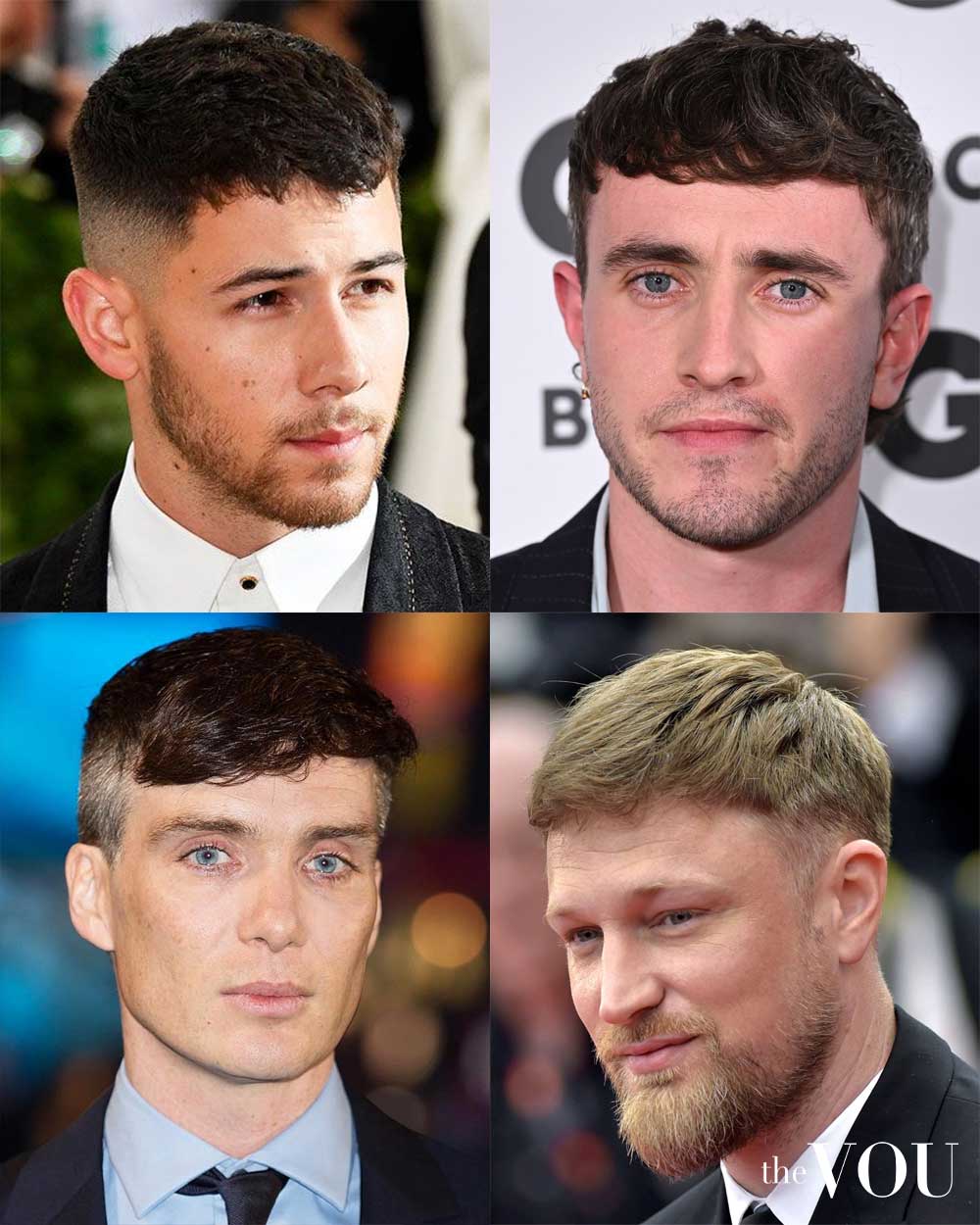
The French Crop exemplifies elegance, characterised by its short sides and back with a slightly longer fringe.
This versatile style balances professional polish and contemporary flair, making it an excellent choice for the modern gentleman.
Face Shape Suitability
The French Crop’s adaptability shines through its suitability for various face shapes. Oval and square faces benefit from the style’s clean lines, accentuating strong jawlines.
For round faces, a textured fringe creates the illusion of length, while those with diamond-shaped faces find balance in the crop’s proportions.
Hair Type
This style accommodates a range of hair types, from fine to thick.
Fine hair gains volume through textured cutting techniques, whilst thick hair benefits from thinning to achieve the desired shape.
The crop offers a sleek finish for straight hair, while wavy textures add natural movement to the fringe.
Maintenance
The French Crop demands minimal upkeep, requiring trimming every 3-4 weeks to maintain its sharp silhouette.
Regular shampoo and conditioning suffice daily care, with occasional deep cleansing to remove product build-up and maintain scalp health.
Styling Tips
To achieve the quintessential French Crop look, apply a pea-sized matte clay or paste to towel-dried hair.
Work the product through with your fingers, focusing on creating texture in the fringe.
For a sleeker finish, use a fine-toothed comb to style the fringe forward.
A light mist of medium-hold hairspray ensures longevity without compromising the style’s natural movement.
Historical Context
The French Crop traces its roots to the 1960s mod subculture, where it emerged as a refined alternative to longer, more rebellious styles.
Its resurgence in recent years speaks to a renewed appreciation for minimalist grooming aesthetics.
Modern Variations
Contemporary interpretations of the French Crop include the textured crop, featuring a more messy fringe, and the crop fade, incorporating a gradual side fade for a sharper contrast.
These variations offer personalised options while maintaining the style’s classic essence.
Professional vs Casual Adaptability
The French Crop’s versatility allows for seamless transitions between professional and casual settings.
For formal occasions, style the fringe neatly with a matte pomade for a polished look.
In casual contexts, embrace a more tousled appearance using salt spray for added texture.
Grooming Tools
Essential tools for maintaining the French Crop include high-quality hair scissors for fringe trimming, a fine-toothed comb for precise styling, and a natural bristle brush to distribute natural oils and maintain scalp health.
Common Mistakes
Avoid over-styling the fringe, resulting in a rigid, unnatural appearance.
Refrain from excessive product, which weighs down the hair and diminishes the style’s effortless appeal.
When requesting this cut, clearly communicate the desired fringe length to prevent an excessively short crop.
Celebrity Examples
Notable advocates of the French Crop include actors Cillian Murphy and Paul Mescal and musicians Nick Jonas and Skread.
Their interpretations demonstrate the cut’s ability to complement diverse personal styles and facial features.
10. The Shoulder Length Cut – Bohemian Elegance
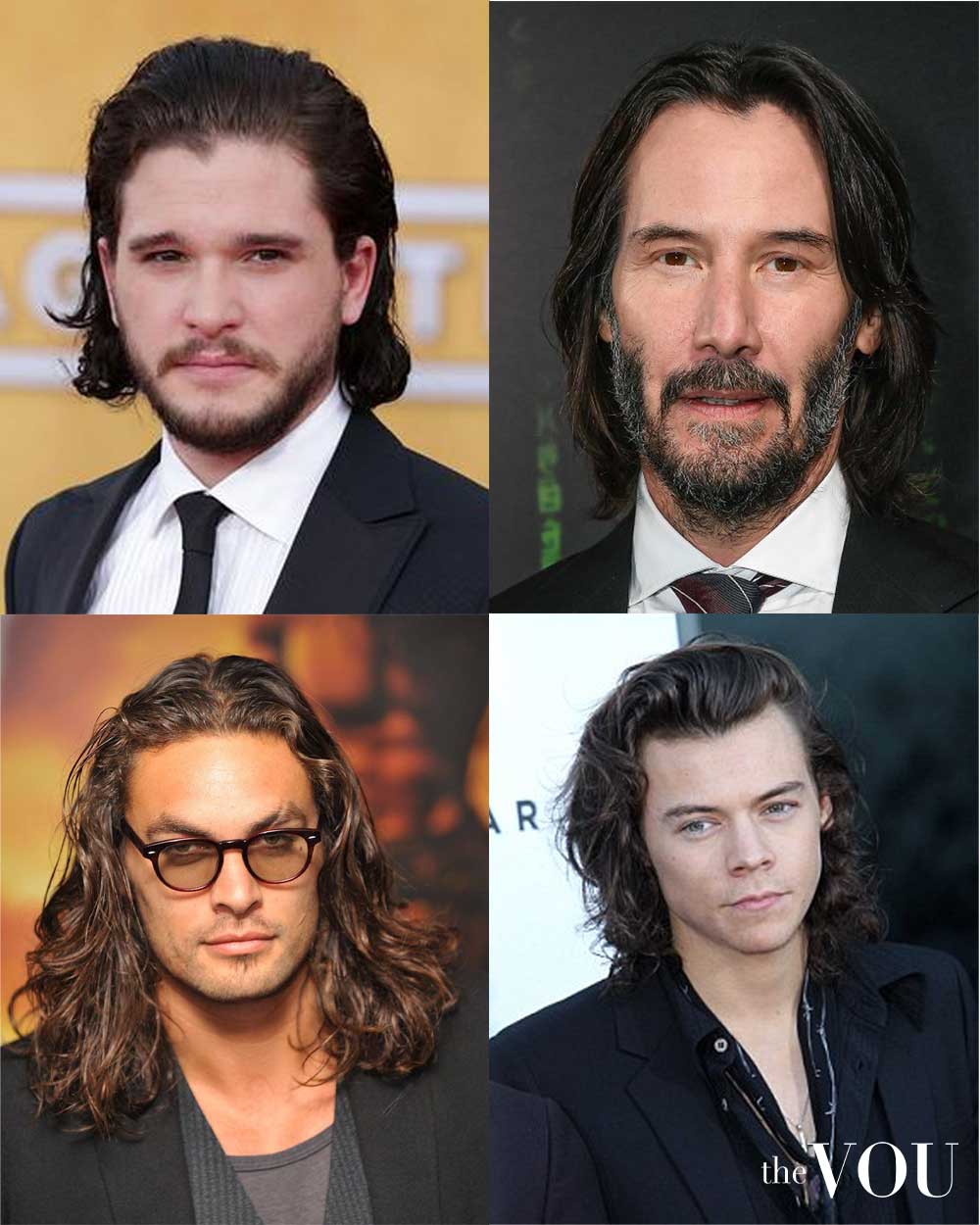
The Shoulder Length Cut embodies bohemian elegance, characterised by its flowing, versatile nature.
This style exudes a sense of artistic freedom and self-expression, making it a popular choice for men who wish to project creativity and individuality.
Face Shape Suitability
The Shoulder Length Cut adapts well to various face shapes – oval faces benefit from its balanced frame, while the added width softens long faces.
For round faces, layers can create a lengthening effect.
Square faces find their strong features complemented by the style’s softer lines.
Those with heart-shaped faces can use this length to balance wider foreheads.
Hair Type Considerations
Straight hair at this length can appear sleek and polished or tousled for a more casual look.
Wavy hair naturally enhances the style’s bohemian essence.
Curly hair may require additional maintenance but offers a striking, voluminous appearance.
Fine hair benefits from layers to create the illusion of thickness.
Maintenance Requirements
The Shoulder Length Cut requires consistent upkeep to maintain its shape and health.
Trimming every 8-10 weeks prevents split ends and maintains the style’s integrity.
Daily care involves gentle washing and conditioning to preserve natural oils.
Regular deep conditioning treatments are essential to combat dryness and maintain shine.
Styling Tips
To style, start with damp hair by applying a heat-protectant spray and a wide-toothed comb to detangle gently.
For a natural look, apply a small amount of sea salt spray and allow the air to dry.
Use a round brush while blow-drying to create volume and shape for a more polished appearance.
Finish with a light hold styling cream to define layers and control frizz.
Historical Context
The Shoulder Length Cut gained popularity in the 1960s and 1970s, symbolising counter-culture and artistic expression.
It has since evolved into a versatile style, embraced by various subcultures and mainstream fashion alike.
In recent years, it has seen a resurgence as part of the broader trend towards gender-neutral styling.
Modern Variations
Contemporary interpretations include the Textured Shoulder Length, featuring choppy layers for added movement.
The Slicked-Back Shoulder Length offers a more formal option for longer styles.
For a bold statement, the Asymmetrical Shoulder Length incorporates varying lengths for a dynamic silhouette.
Professional vs Casual Adaptability
In professional settings, the hair can be tied back neatly or styled sleekly for a refined appearance.
For casual occasions, embrace natural texture and movement for a relaxed, effortless look.
The style’s length allows for various updos, offering versatility for different dress codes and events.
Grooming Tools
Essential tools include a wide-toothed comb for detangling and a boar bristle brush for distributing natural oils.
Invest in high-quality hair ties and pins for creating various updos.
A diffuser attachment for your hair dryer enhances natural texture and reduces frizz.
Common Mistakes
Avoid over-washing, which can strip natural oils and lead to dryness and frizz.
Please refrain from using excessive heat styling, which can damage the hair and diminish its natural texture.
Regular trims are crucial when growing out shorter styles to maintain shape and prevent an unkempt appearance.
Celebrity Examples
Actors Keanu Reeves and Kit Harington have showcased different versions of the Shoulder Length Cut, demonstrating its rugged appeal.
Musician Harry Styles has popularised various iterations of this length, highlighting its versatility.
Actor Jason Momoa’s interpretation of the style emphasises its bold, masculine potential.
11. The Buzz Cut – Minimalist Masculinity
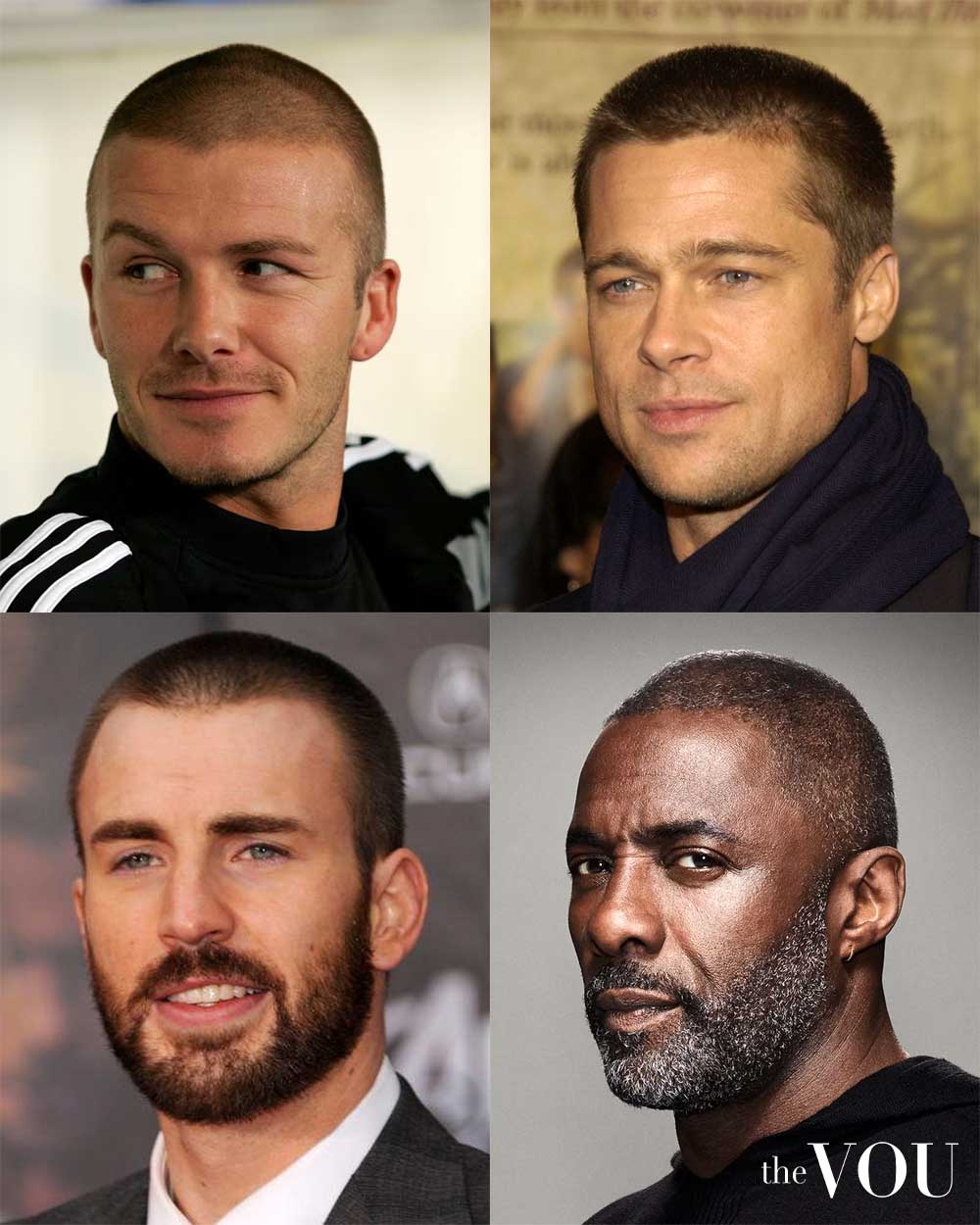
The Buzz Cut epitomises minimalist masculinity, characterised by its uniform short length across the entire scalp.
This bold style exudes confidence and practicality, offering a low-maintenance option for the modern man who values simplicity and assertiveness in his appearance.
Face Shape Suitability
The Buzz Cut’s suitability varies across face shapes. Oval and square faces benefit from the style’s ability to accentuate strong facial features.
For round faces, a slightly longer buzz on top creates the illusion of length. Diamond-shaped faces should opt for a uniform length to balance proportions.
Those with prominent ears or irregular skull shapes may find this style less flattering, as it offers minimal coverage.
Hair Type
This style proves universally adaptable across hair types. Fine hair appears denser when buzzed short, while thick hair becomes more manageable.
For those with thinning hair, the Buzz Cut camouflages areas of hair loss by creating a uniform appearance.
Curly and wavy hair textures are simplified, resulting in a neat, consistent look.
Maintenance
The Buzz Cut demands minimal maintenance, requiring trimming every 2-3 weeks to preserve its sharp appearance.
Daily care involves gentle cleansing with a mild shampoo to prevent scalp irritation. Regular exfoliation helps prevent ingrown hairs and maintains scalp health.
Sun protection becomes crucial, necessitating the application of SPF to the exposed scalp.
Styling Tips
Styling the Buzz Cut primarily involves maintaining its shape.
After showering, towel dry the hair and apply a small amount of leave-in conditioner to nourish the scalp and hair follicles.
For a matte finish, work a pea-sized amount of hair wax through the hair using fingertips.
To add a subtle sheen, apply a light misting of the grooming tonic.
Historical Context
The Buzz Cut’s origins trace back to military practicality, where it facilitated hygiene and uniformity among soldiers.
Its adoption in civilian life began in the 1960s as a rebellion against longer, more elaborate styles.
The cut has since become a symbol of no-nonsense masculinity and contemporary minimalism.
Modern Variations
Contemporary interpretations include the Buzz Cut Fade, featuring gradual tapering on the sides and back, and the Textured Buzz, which leaves slightly more length on top for added dimension.
The Burr Cut, with its ultra-short length, offers an even more extreme iteration for those seeking a bold statement.
Professional vs Casual Adaptability
The Buzz Cut’s simplicity lends itself to both professional and casual environments. In formal settings, maintain a precise, freshly-trimmed appearance.
For casual occasions, a slightly grown-out Buzz Cut adds a rugged edge.
The style’s versatility allows easy accessorising with statement eyewear or facial hair to suit different contexts.
Grooming Tools
Essential tools for maintaining the Buzz Cut include high-quality hair clippers with multiple guard lengths, allowing for precise trimming at home.
A handheld mirror facilitates even cutting at the back of the head.
Invest in a soft-bristled brush to exfoliate the scalp and stimulate blood flow, promoting healthy hair growth.
Common Mistakes
Avoid using too short guards, which can result in scalp visibility.
Neglecting regular maintenance leads to an unkempt appearance, diminishing the style’s sharp aesthetic.
When buzzing at home, ensure even pressure and consistent direction to prevent patchy results.
Failing to adapt the style to one’s head shape can accentuate unflattering features.
Celebrity Examples
Prominent figures sporting the Buzz Cut include actor Idris Elba, Chris Evans, and Brad Pitt who frequently showcases the style in various lengths, demonstrating its versatility.
Football player David Beckham has sometimes embraced the Buzz Cut, highlighting its appeal in athletic contexts.
Style Like A Pro
Before we say goodbye, here’s one of the best-kept secrets in men’s styling circles, a secret that only a few expert image consultants know or are willing to share:
First and foremost, professional styling requires knowing your unique body shape and seasonal colour palette – paramount factors in choosing perfectly fitting clothes in colours that complement your skin, eyes, and hair.
Only then can a stylist engage in styling by occasion, location, season, and time of day, with garments, footwear, and accessories from stylistically relevant, heritage fashion brands to depict high confidence and success.
Best part? You can find your body shape, seasonal colour palette, and ideal fashion style, in less than 5 minutes, by yourself, for free, thanks to our 3 simple steps, below:
1. Find Your Body Shape
Different garments flatter different silhouettes, so knowing your body shape is the first step in dressing like a confident man.
To find out your unique body shape, take our free body shape quiz for men.
Once you know your unique body shape, take the second free quiz to discover your unique colour palette.
2. Find Your Unique Colour Palette
Remember, the garments that compose your outfits come in various colours and you have to make sure that each hue complements your natural colour.
For that, you have to find out your seasonal colour palette, and you can do it by taking our free seasonal colour quiz for men.
3. Find Your Ideal Fashion Style
By now, you should already know your body shape and unique colour palette; the next step is to discover your ideal personal fashion style.
The fastest and simplest way is to take our free fashion style quiz for men; it includes your ideal style, outfit ideas, relevant fashion brands, and much more.
4. Professional Image Consultancy with The VOU
And if you want to style like a professional, by occasion, location, season, and time of the day, you can always ask our expert image consultants and fashion stylists for help.
Our styling services for men are the most comprehensive and detailed on the market, backed up by leading stylists who will guide you step by step in creating looks that communicate affluence, elegance, and endless accomplishments.
Remember, wearing luxury brands isn’t enough; to look stylish, confident, and successful, you must first know your body shape, colour palette, and ideal personal style, and only then style by occasion, location, season, and time of day.
Contact us today to save headaches, time, and money – it’s time to dress like a confident, successful gentleman of exquisite fashion taste – the first styling assessment is on us!
With years of expertise in high-end fashion collabs and a PhD in Sustainable Fashion, Ru specialises in eco-luxe wardrobes for the modern gentleman seeking understated refinement.
A passionate advocate for inclusivity and diversity, Aidan is the driving force behind The VOU as its Editorial Manager. With a unique blend of editorial acumen and project management prowess, Aidan's insightful articles have graced the pages of The Verge, WWD, Forbes, and WTVOX, reflecting his deep interest in the dynamic intersection of styling with grooming for men and beyond.
With over twenty years of front-row fashion and styling events, collabs with haute-couture houses, and a PhD in Luxury Fashion, Laurenti is an expert in crafting personalised looks that depict old-money sophistication.


